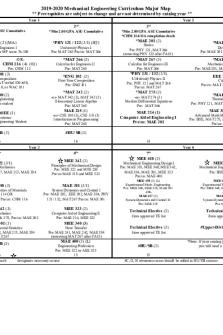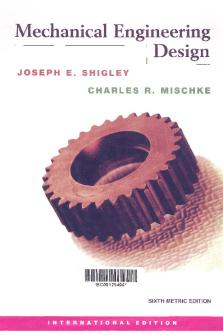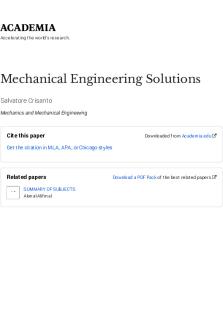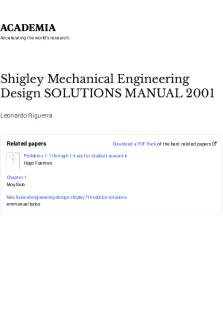MECHANICAL ENGINEERING REVIEW MANUAL PDF

| Title | MECHANICAL ENGINEERING REVIEW MANUAL |
|---|---|
| Author | Yuri G Melliza |
| Pages | 509 |
| File Size | 17.2 MB |
| File Type | |
| Total Downloads | 539 |
| Total Views | 598 |
Summary
MECHANICAL ENGINEERING REVIEW MANUAL By : ENGR. YURI G. MELLIZA 1 PART 1:THERMODYNAMICS DEFINITION OF TERMS Mass: It is the absolute quantity of matter in it. m – mass, kg Conversion 1 kg = 2.205 lbs 1 Metric Ton = 1,000 kg 1 Ton = 2000 Lbs Velocity: It is the distance per unit time. d m v t sec Wh...
Description
MECHANICAL ENGINEERING REVIEW MANUAL
By : ENGR. YURI G. MELLIZA
1
PART 1:THERMODYNAMICS DEFINITION OF TERMS Mass: It is the absolute quantity of matter in it. m – mass, kg Conversion 1 kg = 2.205 lbs 1 Metric Ton = 1,000 kg 1 Ton = 2000 Lbs Velocity: It is the distance per unit time.
d m t sec Where d – distance, m t – time, sec v
Conversion 1 meter = 3.28 ft = 100 cm = 1000 mm 1 ft. = 12 inches Acceleration: Rate of change of velocity with respect to time. dv m a dt sec 2 Gravitational Acceleration: It is the acceleration due to gravity. At standard condition or Sea level condition: g = 9.81 m/sec2 = 32.2 ft/sec2 Force: It is the mass multiplied by the acceleration. F ma N (Newton) F
ma KN (Kilo Newton) 1000
Newton: It is the force required to accelerate 1 kg mass at the rate of 1 m/sec per second. Where: m – mass in kg a – acceleration in m/sec2 Weight: It is the forge due to gravity. W mg N mg KN 1000 where W
g - gravitatio nal accelerati on, g 9.81
m sec2
m Standard gravitatio nal accelerati on sec2
2
Force of Attraction: From Newton’s Law of Gravitation the force of attraction between two masses m1 and m2 is given by the equation: Fg
Gm1m 2
Newton
r2
Where: m1 and m2 - masses in kg r - distance apart in meters G - Gravitational constant in N-m2/kg2 G 6.670 x 10-11
N - m2 kg 2
PROPERTIES OF FLUIDS Density () - it is the mass per unit volume. ρ
m kg V m3
Where: m - mass, kg V - volume , m3 Conversion: 1 1
lb ft 3 kg
16.0185
3
kg m3
62,427.9606
cm g kg 1 1 3 liter m
lb ft 3
Specific volume () - it is the volume per unit mass or the reciprocal of its density. υ
V m3 m kg
υ
1 m3 ρ kg
Specific weight () - it is the weight per unit volume. W KN V m3 mg KN γ 1000V m 3 ρg KN γ 1000 m 3 1000γ kg ρ g m3 γ
Specific Gravity Or Relative Density (S): FOR LIQUIDS: Its specific gravity or relative density is equal to the ratio of its density to that of water at standard temperature and pressure.
SL
ρ γ L ρw γw
3
At standard condition: water = 1000 kg/m3 water = 9.81 KN/m3 FOR GASES: Its specific gravity or relative density is equal to the ratio of its density to that of either air or hydrogen at some specified temperature and pressure PV mRT P kg RT m 3 8.3143 KJ R M kg - K
ρ
Where: ah - density of either air or hydrogen at some value of P and T.
Equation of State for Gases
Conversion F 32 1 .8 F 1.8(C) 32 C Where: P – absolute pressure in KPa V – volume in m3 m – mass in kg R – Gas constant in KJ/kg-K T – absolute temperature in K. M – molecular weight of gas, kg/kgmol
Temperature: It is the measure of the intensity of heat. FAHRENHEIT SCALE Freezing Point = 32F Boiling Point = 212F CENTIGRADE SCALE Freezing Point = 0C Boiling Point = 100C ABSOLUTE SCALE
ρG SG ρ AH
R = F + 460 K = C + 273
4
Pressure: - is defined as the normal component of a force per unit area. F KN or KPa (Kilo Pascal) A m2 KN 1 2 1 KPa m P
If a force dF acts on infinitesimal area dA the intensity of pressure P is P
dF dA
PASCAL`S LAW At any point in a homogeneous fluid at rest the pressures are the same in all directions.
Atmospheric Pressure (Pa): It is the average pressure exerted by the atmosphere. At sea level (Standard Condition) Pa
1Bar 1MPa
= = = = = = = = = =
101.325 0.101325 760 10.33 1.033 14.7 29.921 33.88 100 1000
KPa MPa mm Hg m of H2O Kg/cm2 Lb/in2 in Hg Ft of H2O KPa KPa
ABSOLUTE AND GAGE PRESSURE Absolute Pressure - is the pressure measured referred to absolute zero and using absolute zero as the base. Gage Pressure - is the pressure measured referred to atmospheric pressure and using atmospheric pressure as the base.
5
VARIATION OF PRESSURE WITH DEPTH OR ELEVATION
Viscosity: It is the property of a fluid that determines the amount of its resistance to shearing stress.
6
Kinematic Viscosity: It is the ratio of the absolute or dynamic viscosity to the mass density. μ m2 ν ρ sec Elasticity: If a pressure is applied to a fluid, it contracts; if the pressure is released, it expands, the elasticity of a fluid is related to the amount of deformation(expansion or contraction) for a given pressure change. Quantitatively, the degree of elasticity is equal to: dP Ev dV V
Where negative sign is used because dV/V is negative for a positive dP. Ev
dP dV dρ ; because ρ dρ V ρ
Where: Ev - bulk modulus of elasticity dV - is the incremental volume change V - is the original volume dP - is the incremental pressure change Surface Tension: Capillarity Surface tension is the tendency of fluid surfaces to shrink into the minimum surface area possible. Surface tension allows insects, usually denser than water, to float and slide on a water surface. Capillarity is the result of surface, or interfacial, forces. The rise of water in a thin tube inserted in water is caused by forces of attraction between the molecules of water and the glass walls and among the molecules of water themselves.
h
r
2σ cos θ γr
h
7
Where: - surface tension, N/m - specific weight of liquid, N/m3 r – radius, m h – capillary rise, m Table 1.Surface Tension of Water C 0 0.0756 10 0.0742 20 0.0728 30 0.0712 40 0.0696 60 0.0662 80 0.0626 100 0.0589
Entropy (S): It is a property of a fluid that determines the amount of its randomness and disorder of a substance. If during a process an amount of heat is taken at certain instant and is divided by the absolute temperature at which it is taken the result is called the “Change of Entropy” T Area Heat
1
dQ TdS
T
ΔS
2
dS
dQ T dQ TdS dS
T
dQ
S
MANOMETERS Manometer is an instrument used in measuring gage pressure in length of some liquid column. 1. Open Type Manometer : It has an atmospheric surface and is capable in measuring gage pressure. 2. Differential Type Manometer : It has no atmospheric surface and is capable in measuring differences of pressure. Open Type
Differential Type
8
Problem No. 1 (Force of Attraction) How far from the earth must a body be along a line toward the sun so that the gravitational pull of the sun balances that of the earth? Earth to sun distance is 9.3 x 107 mi; mass of sun is 3.24 x105 times mass of earth. (1.63 x 105 mi.)
Problem No. 2 (Measuring Temperature) If the F scale is twice the C scale, what will be the corresponding reading in each scale? (160 ; 320) F 32 C 1.8 F 1.8C 32 F 2C 2C 1.8C 32 32 C 160 2 1 .8 F 320
9
Problem No. 3 (Density, Specific gravity) A cylindrical tank 2 m diameter, 3 m high is full of oil. If the specific gravity of oil is 0.9, what is the mass of oil in the tank? (8482.3 kg)
Vcylinder S
π 2 π D H (2 2 )3 3π m 3 4 4
ρ ρ water
ρ 1000 kg ρ 900 3 m m ρ V m 900(3π) 8482.3 kg 0 .9
Problem No. 4 (Variation in Pressure) An open tank contains 5 m of water covered with 2 m of oil ( = 8 KN/m3). Find the pressure at the interface and at the bottom of the tank.
Problem No. 5 (Force) 10 liters of an incompressible liquid exert a force of 20 N at the earth’s surface. What force would 2.3 Liters of this liquid exert on the surface of the moon? The gravitational acceleration on the surface of the moon is 1.67 m/sec2. F ma ρ
m V
1 m3 kg m ρV ρ(10.0) 1000 L ρ(10.0) 9.81 N 20 1000 kg ρ 203.874 3 m On the surface of the moon 2 .3 F 203.874 (1.67) 0.783 N 1000
10
Problem No. 6 (Manometer) An open manometer is used to measure the pressure in the tank. The tank is half filled with 50,000 kg of a liquid chemical that is not miscible in water. The manometer tube is filled with liquid chemical. What is the pressure in the tank relative to atmospheric pressure?
4 1 2 2 V πr 3 πr 2 (6) πr 3 πr 2 (3) πr 2 r (3) 54.45 m 3 3 2 3 3 m 50,000 kg ρ 918.2 3 V 54.45 m ρg 918.29.81 KN γ 9.008 3 1000 1000 m P 9.008(0.225) 0.350(9.81) 0 P 1.4067 KPa Pa bs 101.325 1.4067 102.73 KPa
Problem No. 7 (Temperature) If the temperature inside a furnace is 700 K, what is the corresponding reading in F? (800.6) Solution: t = 700 – 273 = 427C F = (427)(1.8) + 32 F = 800.6F Problem No. 8 (Absolute Pressure) The suction pressure of a pump reads 540 mm Hg vacuum. What is the absolute pressure in KPa? ( 29.33) Solution: P = 760 – 540 = 220 mm Hg absolute P
220 (101.325) 29.33 mm Hg 760
Problem No. 9 (Pressure Variation) A storage tank contains oil with a specific gravity of 0.88 and depth of 20 m. What is the hydrostatic pressure at the bottom of the tank in kg/cm2.(1.7) Solution: Using: g = 9.81 m/sec2 0.88(1000)(9.81)(20) P 0 172.656 KPa 1000 P = 1.7 kg/cm2 Problem No. 10 (Variation in Pressure Measuring Altitude of Mountain) A hiker carrying a barometer that measures 101.3 KPa at the base of the mountain. The barometer reads 85 KPa at the top of the mountain. The average air density is 1.21 kg/m3. Determine the height of the mountain. dP γdh P2 P1 γ(h 2 h1 ) h 2 h1 h (P1 P2 )1000 ρg (101.3 85)1000 h 1.21(9.81) h 1373 m h
11
MANOMETER PROBLEMS 1.
The closed tank in the figure is filled with water. The pressure gage on the tank reads 50 KPa. Determine a. The height h in mm in the open water column b. The gage pressure acting on the bottom of the tank surface AB c. The absolute pressure of the air in the top of the tank if the local atmospheric pressure is 101 KPa absolute.
By applying principles in variati on of pressure 50 9.81(0.60) - 9.81(h) 0 h 5.7 m PBottom 50 9.81(1.2) 61.8 KPa Pabsolute 50 101 151 KPa absolute
2.
The mercury manometer in the figure indicates a differential reading of 30 m when the pressure in pipe A is 30 mm Hg vacuum. Determine the pressure in pipe B.
30(101.325) 4 KPa 760 - 4 (9.81)1.5 13.6(9.81)(0.30) - 0.9(9.81)(0.45) PB PA
PB 46.8 KPa
3.
A closed tank contains compressed air and oil (S = 0.90) as shown in the figure.a U – tube manometer using mercury (S = 13.6) is connected to the tank as shown. For column heights h1 = 90 cm; h2 = 15 cm and h3 = 22 cm, determine the pressure reading of the gage.
12
4.
The pressure of gas in a pipeline is measured with a mercury manometer having one limb open to the atmosphere. If the difference in the height of mercury in the limbs is 562 mm, calculate the absolute gas pressure. The barometer reads 761 mm Hg, the acceleration due to gravity is 9.79 m/sec2 and SHg = 13.64.
5.
A turbine is supplied with steam at a gauge pressure of 1.4 MPa, after expansion in the turbine the steam flows into a condenser which is maintained at a vacuum of 710 mm Hg. The barometric pressure is 772mm Hg. Express the inlet and exhaust pressure in kg/cm2 . Take the S of mercury is 13.6. 772(101.325) Patm 103 KPa 760 1.033 kg 2 cm 1.05 kg PInlet 1400 103 1503 KPa (absolute) x cm 2 101.325 KPa 1.033 kg 2 710(101.325) cm 0.09 kg PExhaust 103 x (Absolute) cm 2 760 101.325 KPa
6.
The pressure of steam flowing in a pipe line is measured with a mercury manometer. Some steam condenses in to water. Estimate the steam pressure in KPa. Take the density of mercury as 13,600 kg/m3, the barometer reading as 76.1 cm Hg and g = 9.806 m/sec2.
0 13.6(9.806)(0.50) 9.806(0.03) PSteam PSteam 66.4 KPag
76.1(101.325) 167.85 KPa (Absolute) 76
LAW OF CONSERVATION OF MASS Mass is indestructible. In applying this law we must except nuclear processes during which mass is converted into energy. b 1 m1
c
a
d m
2 m2
The verbal Form of the law is: Mass Entering - Mass Leaving = Change of Mass Stored in the system In equation form: m1 m 2 Δm
13
For a Closed System, a system of fixed mass, no equation is necessary. But for a steady-state, steady flow (SSSF) system (OPEN SYSTEM) m = 0. Therefore: m1 m 2 0 ; therefore m1 m 2
For one dimensional flow, the mass flow rate, m in kg/sec is equal to
m ρAv
Av υ
From m1 = m2 = m
ρ1A1v1 ρ 2 A 2 v 2 ρAv A1v1 A 2 v 2 Av υ1 υ2 υ Where: m – mass flow rate in kg/sec A - cross sectional area in m2 v - velocity in m/sec - specific volume in m3/kg - density in kg/m3 Problem No. 1 A counter flowing heat exchanger is used to cool air at 540 K, 400 KPa to 360 K by using 0.05 kg/sec supply of water at 20C, 200 KPa. The airflow is 0.5 kg/sec in a 10 cm diameter pipe. Find the inlet velocity and the water exit temperature. Problem No.2
Problem No. 3
FORMS OF ENERGY Work: It is the force multiplied by the displacement in the direction of the force.
2
W F dx 1
By convention: -W - indicates that work is done on the system +W - indicates that work is done by the system.
Heat: It is a form of energy that crosses a system's boundary, because of a temperature difference between the system and the surrounding. Q - Heat By convention: +Q - indicates that heat is added to the system -Q - indicates that heat is rejected from the system.
14
Internal Energy: It is the energy acquired due to the overall molecular interaction, or the total energy that a molecule has. U = mu KJ Where U - total internal energy KJ, KW u - specific internal energy KJ/kg U- change of internal energy m - mass kg, kg/sec Flow Eneregy Or Flow Work: It is the energy required in pushing a fluid usually into the system or out from the system.
Ef Flow work or Flow energy E f1 F1L1 P1A1L1 P1V1 E f2 F2 L 2 P2 A 2 L 2 P2 V2 ΔEf E f2 E f1
ma 1000 dv a dt F
m 1000 m ΔKE 1000 dx v dt ΔKE
ΔEf P2 V2 P1V1 ΔEf ΔPV
ΔPV P2 V2 P1V1 KJ; KW ΔPυ P2 υ 2 P1υ1
ΔKE F dx
2 dv
dt dx dx dv dt 1 2 1
KJ kg
Kinetic Energy: It is the energy acquired due to the motion of a body or a system.
ΔKE ΔKE ΔKE
m 2 v dv 1000 1
2
m v 1000 2
1 m v 2 v12
v
2(1000)
KJ; KW
v12 KJ 2(1000) kg m kg; kg / sec
ΔKE
2
2
m3 V m ; sec 3
2
2
P KPa
m3 υ kg 1 υ ρ
15
Potential Energy: It is the energy required by virtue of its configuration or elevation. m
2
z
m
1 Reference Datum ΔPE W dz
mg W 1000 mg 2 ΔPE dz 1000 1 mg (z 2 z1 ) ΔPE KJ; KW 1000 g (z 2 z1 ) KJ ΔPE 1000 kg m kg; kg / sec
Where: Z - elevation in m, (+) if above datum and (-) if below datum g - gravitational acceleration, m/sec2 Enthalpy (h): It is the sum of the Internal Energy and the Flow Energy. h U PV KJ Δh ΔU Δ(PV) KJ Δh Δu Δ(Pυ)
KJ kg
ZEROTH LAW OF THERMODYNAMICS If two bodies are in thermal equilibrium with a third body, they are in thermal equilibrium with each other, and hence their temperatures are equal. SPECIFIC HEAT: It is the amount of heat required to raise the temperature of a 1 kg mass, 1 K or 1 C. C
dQ dQ KJ KJ or dt dT kg - C kg - K
then dQ = Cdt by integration, where C is constant Q C ( Δt ) C ( ΔT ) Considerin g m (mass) Q mC (Δt ) mC (ΔT ) where : Δt Δ T t - temperatu re in C T - absolute temperatu re in K
16
Sensible Heat: The amount of heat per unit mass that must be transferred (added or remove) when a substance undergoes a change in temperature without a change in phase. Q mC (Δt ) mC (ΔT) Where: m - mass , kg C - heat capacity or specific heat, KJ/kg-C or KJ/kg-K t - temperature in C T - temperature in K
HEAT OF TRANSFORMATION (LATENT HEAT): The amount of heat per unit mass that must be transferred when a substance completely undergoes a phase change without a change in temperature. Q mh A. Heat of Vaporization: Amount of heat that must be added to vaporize a liquid or that must be removed to condense a gas. Q mh v Where hv- latent heat of vaporization, KJ/kg
B. Heat of Fusion : Amount of heat that must be added to melt a solid or that must be removed to freeze a liquid. Q mh F Where hF – latent heat of fusion, KJ/kg
WATER EQUIVALENT: The water equivalent of a substance is the mass of water that would require the same heat transfer as the mass of that substance to cause the same change of temperature.
mw
ms C ps C pw
PROPERTIES OF PURE SUBSTANCE A pure substance is one that is uniform and invariable in chemical composition. A pure substance can exist in more than one phase, but its chemical composition must be the same in each phase. For example, if liquid water and water vapor form a system with two phases, the system can be regarded as a pure substance because each phase has the same composition. A uniform mixture of gases can be regarded as a pure substance provided it remains a gas and does not react chemically.
a - sub-cooled liquid b - saturated liquid c - saturated mixture d - saturated vapor e - superheated vapor Considering that the system is heated at constant pressure where P = 101.325 KPa, the 100C is the saturation temperature corresponding to 101.325 KPa, and 101.325 KPa pressure is the saturation pressure at 100C. Saturation Temperature (tsat) - is the highest temperature at a given pressure in which vaporization takes place. Saturation Pressure (Psat) - is the pressure corresponding to the temperature. Sub-cooled Liquid - is one whose temperature is less than the saturation temperature corresponding to the pressure. 17
Compressed Liquid - is one whose pressure is greater than the saturation pressure corresponding to the temperature. Saturated Mixture - a mixture of liquid and vapor at the saturation temperature. Superheated Vapor - a vapor whose temperature is greater than the saturation temperature. Temperature - Specific volume Diagram (T- diagram)
Region I – Sub-cooled Liquid Compressed Liquid region Region II -Saturated Mixture region Region III - Superheated Vapor region F (critical point)- at the critical point the temperature and pressure is unique. For Steam: At Critical Point, P = 22.09 MPa; t = 374.136C
Temperature-Entropy Diagram (T-S Diagram)
Entropy (S): Is that property that determines the randomness and disorder of a substance. If during a process, an amount of heat is taken and is divided by the absolute temperature at which it is taken the result is called the “Change of Entropy...
Similar Free PDFs

MECHANICAL ENGINEERING REVIEW MANUAL
- 509 Pages

MECHANICAL ENGINEERING REVIEW MANUAL
- 509 Pages

Mechanical-engineering
- 1 Pages

Mechanical engineering
- 1 Pages

2019-2020 Mechanical Engineering
- 2 Pages

Mechanical Engineering Circuits
- 10 Pages

Mechanical engineering lab report
- 18 Pages

Mechanical Engineering Lecture Notes
- 13 Pages

Mechanical Engineering Elements
- 29 Pages

Mechanical engineering design
- 6 Pages

Mechanical Engineering Solutions
- 21 Pages

Mechanical Engineering Level M
- 16 Pages
Popular Institutions
- Tinajero National High School - Annex
- Politeknik Caltex Riau
- Yokohama City University
- SGT University
- University of Al-Qadisiyah
- Divine Word College of Vigan
- Techniek College Rotterdam
- Universidade de Santiago
- Universiti Teknologi MARA Cawangan Johor Kampus Pasir Gudang
- Poltekkes Kemenkes Yogyakarta
- Baguio City National High School
- Colegio san marcos
- preparatoria uno
- Centro de Bachillerato Tecnológico Industrial y de Servicios No. 107
- Dalian Maritime University
- Quang Trung Secondary School
- Colegio Tecnológico en Informática
- Corporación Regional de Educación Superior
- Grupo CEDVA
- Dar Al Uloom University
- Centro de Estudios Preuniversitarios de la Universidad Nacional de Ingeniería
- 上智大学
- Aakash International School, Nuna Majara
- San Felipe Neri Catholic School
- Kang Chiao International School - New Taipei City
- Misamis Occidental National High School
- Institución Educativa Escuela Normal Juan Ladrilleros
- Kolehiyo ng Pantukan
- Batanes State College
- Instituto Continental
- Sekolah Menengah Kejuruan Kesehatan Kaltara (Tarakan)
- Colegio de La Inmaculada Concepcion - Cebu



